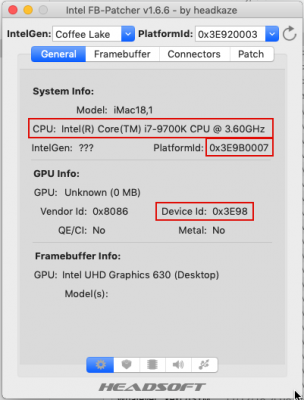CaseySJ
Moderator
- Joined
- Nov 11, 2018
- Messages
- 22,172
- Motherboard
- Asus ProArt Z690-Creator
- CPU
- i7-12700K
- Graphics
- RX 6800 XT
- Mac
- Classic Mac
- Mobile Phone
UPDATE: The complete build guide has been posted here.
Overview
The Gigabyte Designare Z390 has attracted the attention of the Hackintosh community because of its built-in Titan Ridge Thunderbolt 3 controller. This is a full-featured ATX motherboard that also contains a Socket 1 NVMe card for WiFi/Bluetooth. Although the motherboard ships with Intel's latest WiFi/Bluetooth card, MacOS only supports Broadcom devices at this time. The allure of the Socket 1 card, of course, is that new WiFi and Bluetooth versions in the future can be supported by simply exchanging cards.
The purpose of this thread is to share the ongoing status of my attempt to install and configure Mojave on this particular platform (Designare Z390 and 9th Generation Intel Core CPU). Hopefully, others interested in this combination of hardware will find this helpful.
As this is my first Hackintosh, I am not an expert. The moderators are far more experienced, so I am attempting to find and follow every bit of technical information they have provided.
Hardware Summary
Benchmarks
Edit 11/27/2018: Updates in Blue.
Edit 11/28/2018: Updates in Purple.
Edit 12/01/2018: Updates in Green.
Edit 12/02/2018: Updates in Red.
Edit 12/04/2018: Updates in Brown.
Edit 12/05/2018: Updates in Orange.
Edit 12/07/2018 & 12/08/2018: Updates in WhateverColorThisIs.
Edit 12/10/2018: Uploaded PDF showing HSxx/SSxx and Ethernet port layout.
Overview
The Gigabyte Designare Z390 has attracted the attention of the Hackintosh community because of its built-in Titan Ridge Thunderbolt 3 controller. This is a full-featured ATX motherboard that also contains a Socket 1 NVMe card for WiFi/Bluetooth. Although the motherboard ships with Intel's latest WiFi/Bluetooth card, MacOS only supports Broadcom devices at this time. The allure of the Socket 1 card, of course, is that new WiFi and Bluetooth versions in the future can be supported by simply exchanging cards.
The purpose of this thread is to share the ongoing status of my attempt to install and configure Mojave on this particular platform (Designare Z390 and 9th Generation Intel Core CPU). Hopefully, others interested in this combination of hardware will find this helpful.
As this is my first Hackintosh, I am not an expert. The moderators are far more experienced, so I am attempting to find and follow every bit of technical information they have provided.
Hardware Summary
- Gigabyte Designare Z390 motherboard.
- Intel Core i7-9700K 9th Generation CPU (8 cores, 8 threads).
- ADATA SX8200 240GB NVMe v1.3 PCIe x4 SSD -- Boot drive with MacOS and applications.
- Sunbow 1TB 2.5mm 3D NAND SSD -- Contains the home folder (to relocate your home folder, go to Preferences --> Users & Groups --> Right-click your user name on left side --> Choose "Advanced Options..." --> Choose new Home directory.)
- Phanteks Evolv X ATX case with front I/O consisting of two USB 3.0 Type-A ports and a single USB 3.1 Gen 2 Type-C port. These ports are connected via a USB 3 header cable (for Type-A ports) and a USB Type E header cable (for 3.1 Gen 2).
- G.Skill TridentZ 3200Mhz DDR4 memory (4 x 8GB).
- EVGA SuperNova G2 750W Power Supply.
- Raijintek Orcus 280mm All-in-One liquid cooler with dual A-RGB fans.
- Antec Prizm 140mm RGB case fans (because they have A-RGB illumination rings on both sides).
- Arctic MX-4 thermal paste.
- Following the TonyMacx86 Mojave installation procedure, I used UniBeast and a 32GB USB Flash disk to install Mojave on the 240GB NVMe disk. I did not encounter any crashes, panics or unexpected reboots during the installation. MacOS, however, is unable to Reboot or Shutdown the system by itself.
- From Terminal, I used the procedure to test for nvram ("sudo nvram TestVar=Hello", then reboot, then open Terminal again, "sudo nvram -p | grep TestVar") and found that nvram does not exist on this motherboard. This probably explains the inability to Reboot and Shutdown.
- I tried using "EmuVariable64" with a combination of "AptioMemoryFix", but I encountered the dreaded "Cannot allocate memory" error during boot. I then replaced AptioMemoryFix with every other memory fix EFI driver in Clover (one at a time of course), but every attempt failed to boot.
- So for now I've removed "EmuVariable64" and attached a Reset switch to the motherboard to avoid having to power cycle the system every time (the Phanteks case does not have a Reset button).
- Looking at the github page for EmuVariable64, I see that a new version may be coming so I'll wait and try again later.
- Status:
Reboot / Shutdown not working. Waiting for new EmuVariable64. - Status: 11-28-2018: Reboot is working after disabling the "Debug" flag in Boot section of config.plist. Shutdown kernel panics are gone, but Shutdown also reboots the system. EmuVariableUEFI64 driver is not used.
- Status: 12-07-2018: Thanks to this post by @kkho555 both Shutdown and Reboot are finally working. The key is to enable the slide=0 field in Clover Configurator boot options and install EmuVariableUEFI-64.efi. Installing this driver by itself without slide=0 leads to catastrophe! Use the Clover installer (not Clover Configurator) to install EmuVariableUEFI-64.efi, AptioMemoryFix-64.efi, and click the option to Install RC Scripts to Target Volume.
- Update 12-11-2018: In some cases AptioMemoryFix-64.efi will fail on boot. In this case, switch to OsxAptioFix2Drv-free2000.
- Status: Fully working.
- Mojave seemed to recognize all the USB 2 and USB 3 ports by default. The four USB 3.0 Type-A ports on the I/O Shield are governed by a USB Hub at HS07 and SS07, so they seem to count as one USB 2 port and one USB 3 port. When we count up all the USB ports on the I/O Shield we get 2 dedicated USB 2 ports, 2 USB 3.1 ports, and 4 USB 3.0 ports on a Hub (these 4 ports count as 1). So we have 5 HS ports and 3 SS ports on the I/O Shield.
- And we have 2 USB 3.0 ports on the front I/O panel and a Type-C also on the front. These are an additional 3 HS ports and 3 SS ports. And HS14 is internal Bluetooth.
- Sum total: 8 HS ports, 6 SS ports, 1 Blutetooth port (counts as HS port) --- this is a nice total of 15.
- The attached SSDT-UIAC-DESIGNARE-Z390-V2 is for this specific configuration. If you have different front I/O connectors on your case, then this SSDT may not be suitable for you!
- This V2 SSDT keeps HS14 port active (Intel CNVi Bluetooth). But if you plan to use a Broadcom WiFi/BT card with the Bluetooth USB cable plugged into the USB 2.0 header on the motherboard (the header is located to the left of FAN_PUMP) then use SSDT-UIAC-DESIGNARE-Z390-V3 instead (copy the .aml file not the .dsl file to CLOVER/ACPI/patched folder).
- Status: Fully working.
- With the (non-accelerated) iGPU, Sleep causes all screen activity to freeze, but does not turn off or blank out the video. Pressing a key on the keyboard then wakes up the system and the Login screen appears. After logging in, everything resumes.
- With the external GPU (Radeon RX580), Sleep works, but maybe with a little twist. Video turns off, but the case fans and CPU cooler continue to run. To wake, I press and release the power button. A few seconds later the motherboard (but not the OS) reboots and shortly after that the MacOS Login Screen appears (not the boot messages or the Apple Logo on a blank screen).
- Status: With the proper video driver, Sleep/Wake appears to work.
- Update: 12-07-2018: Sleep and Wake also seem to be working correctly after adding slide=0 and installing EmuVariableUEFI-64.efi. Here's the observed behavior:
- Choose: Apple Menu --> Sleep
- Screen goes blank.
- O/S state information is probably written somewhere.
- Drives spin down.
- Chassis and CPU fans turn off.
- GPU turns off.
- Then a click is heard and the motherboard seems to turn off. This whole procedure does take a few seconds.
- However, the RGB lights on my 4 memory DIMMs continue to shine...this is actually a good indication to me that the system isn't off.
- Then I press a key on the keyboard and the fans/drives spin up.
- A few seconds later I press a key again on the keyboard and the Login Screen appears, after which USB devices are back to normal and I pick up where I left off.
- So it's a 2 key wake procedure.
- I only set Darkwake to <empty>. See DARKWAKE screenshot.
- For kicks I tried to sleep a second time (i.e. Power On --> Sleep --> Wake --> Sleep Again), but this time the system actually shut down. So maybe some more tweaking is needed, but this is still a promising start. The first Sleep was okay.
- Update: 12-11-2018: Computer is able to enter Sleep mode automatically after a period of inactivity. It wakes up properly with a single key press. And if the computer sleeps again due to inactivity, it wakes up properly yet again. So sleep/wake/sleep/wake cycle works with auto-sleep.
- Update: 01-06-2019: Use of "darkwake=0" enables wake-from-sleep with one keystroke.
- Status: Fully working.
- The Designare Z390 uses Realtek ALC 1220-VB audio controller.
- By using the debug (not yet released) version of AppleALC 1.3.4, the built-in audio system works!
- Layout ID is 7.
- https://www.tonymacx86.com/threads/no-audio-devices-applehda-realtek-audio.234729/page-146 (see Post 1456 to download the debug version).
- Status: Built-in audio seems to be fully working.
- Because I am using a Radeon RX580, it was a matter a plug-and-play. The card is fully recognized by Mojave, which means even HDMI audio works fine.
- However, when I connect my monitor (via HDMI) to the RX580, I do not see the BIOS screen or the Clover screen. My BIOS is configured to use PCIe-Slot-1 as the Initial Display Output device. However, if I change the BIOS to use iGPU as the Initial Display Output device, then I can see the BIOS and Clover screens, but there's no output from the RX580's HDMI port. I will continue to tinker with this.
Status: Fully working, but some quirks as mentioned above (the quirks I believe are due to BIOS issues).- Status: 12-01-2018: In order to show the RX580 in "System Report --> PCI", I modified KGP's custom SSDT and uploaded it below (SSDT-Z390-DESIGNARE-RX580.aml). The result is shown in one of the screenshots.
- Status: 12-08-2018: The inability to see BIOS screen through the RX580 (described in 2nd bullet above) has been resolved. The RX580 I am using is from an old Ethereum mining rig where I had flashed a low-power BIOS to the card. After flashing the original BIOS back to the card, this final problem has vanished.
- Status: Fully working.
- This has been a real pain. I have tried using iGPU as the only graphics device (removing the RX580 completely), trying different Platform IDs, trying different graphics Device IDs, following every post-installation Graphics fix procedure I could find, using Intel FB-Patcher to change Framebuffer Connector Types and enabling/disabling various connectors, all to no avail.
- The native graphics ID of the UHD in the 9th generation Coffee Lake is 3E98, which Mojave does not currently recognize. But if I specify 3E92 or 3E9B, which Mojave does recognize, then I simply get a black screen out of my HDMI port regardless of framebuffer settings.
- However, this does not mean the computer is frozen or locked up. Because I've installed TeamViewer on this machine, I can remotely log in through my iPad or my MacPro 3,1 or my Windows PC. With remote TeamViewer, I can see and interact with the full Mojave GUI. Better yet, the Intel UHD630 is recognized and I get fully accelerated graphics! But when I select "About this Mac" --> "Displays" I see that the display is set to "Built-In Display" (LVDS?). This might explain why there's no output from an external video connector. I will tinker with this a bit more. I'll start by installing the debug versions of Lilu and Whatevergreen, then dumping the native graphics configuration table.
- If I change the device ID to 3E98, the HDMI port works fine, but I get non-accelerated graphics using the default Apple framebuffer instead of the AppleIntelFramebuffer.
- However, with the Radeon RX580 installed, the monitor connected to the RX580, and the iGPU device ID set to 3E92/3E9B, I get HDMI output from the RX580, but the iGPU does not appear in System Profile. IORegistryExplorer, however, does show the iGPU with the properly accelerated AppleIntelFramebuffer attached!
- At this time, I suspect WhateverGreen is the culprit.
According to the latest github check-ins, it seems a new version is due out shortly with support for the 3E98 device ID. So I will try again later. - Status:
Not working.Does not appear in System Report. Will wait for new WhateverGreen. - Status: 11-28-2018: Even though UHD630 does not appear in System Report, if we use an external graphics card (RX580 in my case) then the iGPU is enabled and VideoProc confirms that it works. Screenshot uploaded. Just to be clear: there is still no video output from the external ports (HDMI in my case), but compute units on the UHD630 are working. This is considered normal for a "headless" configuration.
- Status: Fully working in headless mode,
but not in headed(?) mode. Quicklook and Preview work perfectly. - Update: 01-06-2019: Found a solution for accelerated video through the HDMI port. The UHD630 is now fully utilized -- its compute units accelerate various Mojave functions (HEVC, H.264, Quick Look, Preview, etc.) and its HDMI and two DisplayPort outputs (via USB-C to DP cable) are also functional. Some graphics glitches may appear when using multiple monitors where at least one monitor is driven by the iGPU and at least one is driven by an external (PCIe) GPU. Details are provided in this post.
- Status: Fully working.
- Using the standard intelmausiethernet-kext, the two built-in Ethernet ports work perfectly. No post-install work was needed.
- Status: 12-02-2018: Only one of the two Ethernet ports works -- the one closest to the audio ports. This working Ethernet port is controlled by the PCH and the device ID is recognized by MacOS. The other port, however, is the Intel PRO/1000 with device ID 1539, which MacOS does not recognize. However, the Ethernet port in my OWC 14-Port Thunderbolt 3 Dock works fine.
- Status:
One of two ports fully working. - Status: 12-04-2018: The Intel i211 PRO/1000 Gigabit Ethernet port is finally working with the help of three kexts attached here: (a) FakePCIID.kext, (b) FakePCIID_Intel_GbX.kext, (c) SmallTreeIntel82576.kext. Copy items (a) and (b) to CLOVER/kexts/Other, but copy item (c) to CLOVER/kexts/10.14. (Thanks @pastrychef for the hint.)
- Status: Fully working.
- As expected, Mojave has no support for Intel WiFi/Bluetooth chips so this card does not work.
- Status: Does not work (as expected). Will see if a suitable Broadcom card is available or if someone is nice enough to write a driver for this.
- Status: 12-04-2018: Purchased the following cards today and will install/test them in a day or so. Alas, I'll have to remove the Intel CNVi card and replace it with an older-technology Broadcom card -- at least until an Intel WiFi driver becomes available.
BCM94360CS2 to NGFF M.2 adapter:https://www.amazon.com/dp/B01KHRJVXW/?tag=tonymacx86com-20BCM94360CS2 WiFi/BT card:https://www.amazon.com/dp/B07C78VBCD/?tag=tonymacx86com-20
- Status: 12-05-2018: Due to a PCIe x1 slot located immediately behind the Socket-1, there is insufficient room on this motherboard to install the NGFF M.2 adapter.
Fortunately, the following Socket-1 BCM94352Z card should work.It arrives on Friday the 7th so I'll post an update shortly thereafter. https://www.amazon.com/dp/B079QGV7HG/?tag=tonymacx86com-20 - Status: 12-08-2018: The BCM94352Z Socket 1 card arrived, but upon installation, it did not seem to announce its DeviceID and VendorID to the BIOS. The card may be defective or simply incompatible with the Socket 1 slot or motherboard. So it's back to Amazon for a PCIe x1 adapter and the newer BCM94360CS2 that I returned a couple of days ago. Will update status when both parts arrive (hopefully by Monday the 10th).
- Update: This motherboard uses a CNVi slot that resembles M.2 Type E, but is in fact incompatible. Only CNVi devices will work in this slot. Hence, using a PCIe x1 adapter is the right choice. See details here.
- Update: 12-10-2018: The BCM94360CS2 and PCIe x1 adapter arrived on Sunday. This card works natively out-of-the-box (OOB) and no drivers or kexts are needed. This means no need for AirportBrcmFixup.kext, BrcmFirmwareData.kext, BrcmFirmwareRepo.kext, or BrcmPatchRAM2.kext. See Post #107 for some reboot issues that were encountered. After switching to OsxAptioFix2Drv-free2000, the system seems to finally be booting reliably with no "Couldn't allocate runtime area" errors. Still need to test Continuity/Handoff. However, USB port 14 must be disabled and port 11 must be enabled. This is handled by the attached Custom SSDT SSDT-UIAC-DESIGNARE-Z390-V3. Be careful to copy the .aml file to your CLOVER/ACPI/patched folder. The .dsl file is for reference only -- it provides comments for every port.
- Status: WiFi/BT working, but further tests pending.
- Update: 12-12-2018: Based on this post, I think this is a done deal.
- Status: Fully Working.
- Saved the best for last...
- This motherboard has a built-in Titan Ridge Thunderbolt 3 controller. I was really drawn to this feature even though I initially bought the AORUS Z390 Extreme with the intention of buying Gigabyte's GC-Titan Ridge card from Amazon. I wanted the RGB Fusion capability of the AORUS board and was willing to pay an extra $99 for the Titan Ridge card, but ultimately decided against it because:
- To install the card, you need to run a PCI power cable to the card from the power supply.
- You also need to run a Thunderbolt 3 header cable from the motherboard to the card.
- Because of the glass side panels on the Phanteks case, I simply didn't want to clutter the build with cables running everywhere, so I returned the AORUS and purchased the Designare.
- I don't have any Thunderbolt 3 devices at this time!
- With no devices attached, System Profiler --> Thunderbolt shows "Thunderbolt: No hardware found".
- But I do have a USB Type-C flash disk. When I plug that in and reboot the computer (no hot connect/disconnect capability), System Profiler --> Thunderbolt shows "Thunderbolt: No drivers loaded".
- So this looks promising, but this is as far as I've gotten.
- Status: Promising, but requires further tinkering.
- Status 11-28-2018: Got Titan Ridge Thunderbolt 3 "working", but not fully tested. See details here. Interim SSDTs uploaded here. (SSDT-DTPG.aml and
SSDT-Z390-TB3-IN-PROGRESS.amlshould be copied to "EFI-->CLOVER-->ACPI-->patched" folder.) My SMBIOS is now MacMini8,1. - Status: 12-01-2018: My OWC Thunderbolt 3 dock arrived late on Thursday. After revising Thunderbolt BIOS settings and using a revised custom SSDT (SSDT-Z390-DESIGNARE-TB3HP-V3.aml attached), the dock is finally being recognized. I have only tested (briefly) the USB and Network ports on the dock. Basic functionality is working. Will perform Sleep/Wake tests later.
- Status: 12-02-2018: Looks like I was wrong about the use of "Thunderbolt Boot Support --> Boot Once". This seems to cause BIOS corruption ("couldn't allocate memory" on boot) if left on between multiple reboots. Instead, I believe Thunderbolt Boot Support should be Disabled. But Thunderbolt Security might be the reason why my OWC Dock was not initially recognized. Thunderbolt Security should be Disabled. With these settings my Dock is still being recognized.
Status: Partially working(see Post #71).- Reminder: SSDT-Z390-DESIGNARE-TB3HP-V3.aml must be used in combination with SSDT-DTPG.aml. Both files are attached here and both must be copied to EFI/CLOVER/ACPI/patched folder.
- Update: 12-12-2018: Based on feedback from @NoiseCoalition posted here, Sleep/Wake for the UAD Apollo x8p TB3 audio interface is working. So let's change the status to this:
- Status: Fully working (as far as we can tell; some TB3 drivers might be poorly implemented and may cause trouble).
- Start with Load Optimized Defaults then make (or confirm) the following settings -- important settings in bold:
- M.I.T.
- Extreme Memory Profile (X.M.P.) --> Profile 1
- BIOS
- Windows 8/10 Features --> Other OS
- CSM Support --> Disabled
- Secure Boot will be disabled by default, but good to check
- Peripherals
- Intel Platform Trust Technology (PTT) --> Disabled
- Thunderbolt(TM) Configuration
- TBT Vt-d Base Security --> Disabled
- Thunderbolt Boot Support --> Disabled
- Security Level --> No Security
- Discrete Thunderbolt Configuration
- Thunderbolt USB Support --> Enable/Disable either one is okay
- GPIO3 Force Pwr --> Enabled
- DTBT Configuration (no changes made although I did try the following two, but not sure if there's any benefit):
- Reserved Memory --> 737
- Reserved PMemory --> 1184
- USB Configuration
- Legacy USB Support --> Enabled
- XHCI Hand-off --> Enabled
- Network Stack Configuration
- Network Stack --> Disabled
- Chipset
- Vt-d --> Disabled
- Internal Graphics --> Enabled
- DVMT Pre-Alloc --> 64M
- DVMT Total Gfx Mem --> 256M
- Audio Controller --> Enabled
- Above 4G Decoding --> Enabled
- Power
- ErP --> Disabled
- RC6 (Render Standby) --> Enabled
Benchmarks
- Geekbench CPU Score: Single-Core 6495
- Geekbench CPU Score: Multi-Core 33398
- Geekbench Compute Score (UHD630): 25159 OpenCL
- Geekbench Compute Score (RX580): 136532 OpenCL
Edit 11/27/2018: Updates in Blue.
Edit 11/28/2018: Updates in Purple.
Edit 12/01/2018: Updates in Green.
Edit 12/02/2018: Updates in Red.
Edit 12/04/2018: Updates in Brown.
Edit 12/05/2018: Updates in Orange.
Edit 12/07/2018 & 12/08/2018: Updates in WhateverColorThisIs.
Edit 12/10/2018: Uploaded PDF showing HSxx/SSxx and Ethernet port layout.
Attachments
-
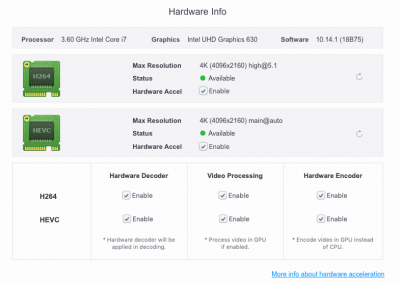 Screen Shot 2018-11-28 at 6.06.05 AM.png91 KB · Views: 3,002
Screen Shot 2018-11-28 at 6.06.05 AM.png91 KB · Views: 3,002 -
SSDT-DTPG.aml100 bytes · Views: 1,116
-
SSDT-Z390-DESIGNARE-RX580.aml1.2 KB · Views: 1,080
-
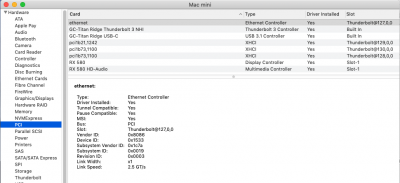 Screen Shot 2018-12-03 at 7.05.30 PM.png92.5 KB · Views: 2,763
Screen Shot 2018-12-03 at 7.05.30 PM.png92.5 KB · Views: 2,763 -
SSDT-Z390-DESIGNARE-TB3HP-V3.aml6.2 KB · Views: 1,237
-
SmallTreeIntel82576.kext.zip67.3 KB · Views: 853
-
FakePCIID.kext.zip13.6 KB · Views: 820
-
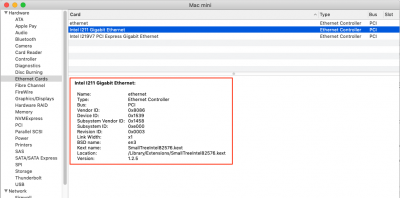 Screen Shot 2018-12-04 at 7.45.54 PM.png79 KB · Views: 2,328
Screen Shot 2018-12-04 at 7.45.54 PM.png79 KB · Views: 2,328 -
FakePCIID_Intel_GbX.kext.zip2.4 KB · Views: 852
-
SSDT-UIAC-DESIGNARE-Z390-V2.aml697 bytes · Views: 898
-
 Geekbench Scores.png56.5 KB · Views: 2,743
Geekbench Scores.png56.5 KB · Views: 2,743 -
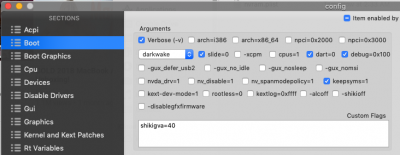 DARKWAKE.png78.5 KB · Views: 2,970
DARKWAKE.png78.5 KB · Views: 2,970 -
config.plist6.8 KB · Views: 1,884
-
SSDT-UIAC-DESIGNARE-Z390-V3.aml696 bytes · Views: 895
-
SSDT-UIAC-DESIGNARE-Z390-V3.dsl7.7 KB · Views: 852
-
Designare-Z390-IO-Layout.pdf1.1 MB · Views: 1,167
Last edited:

